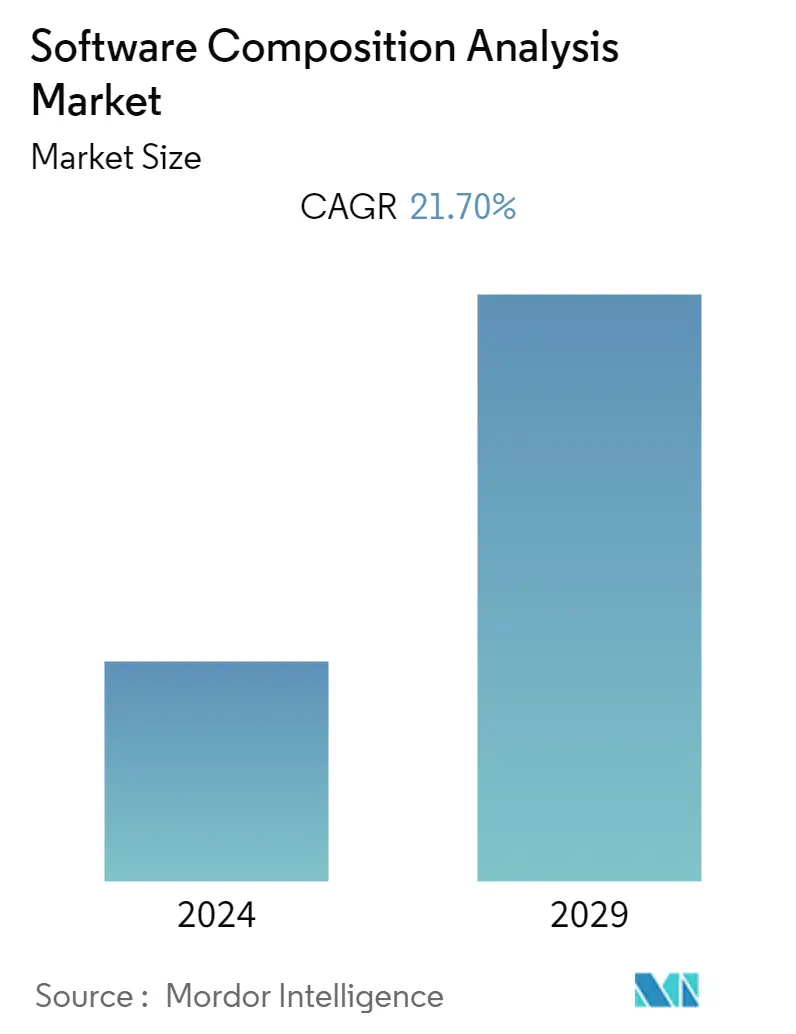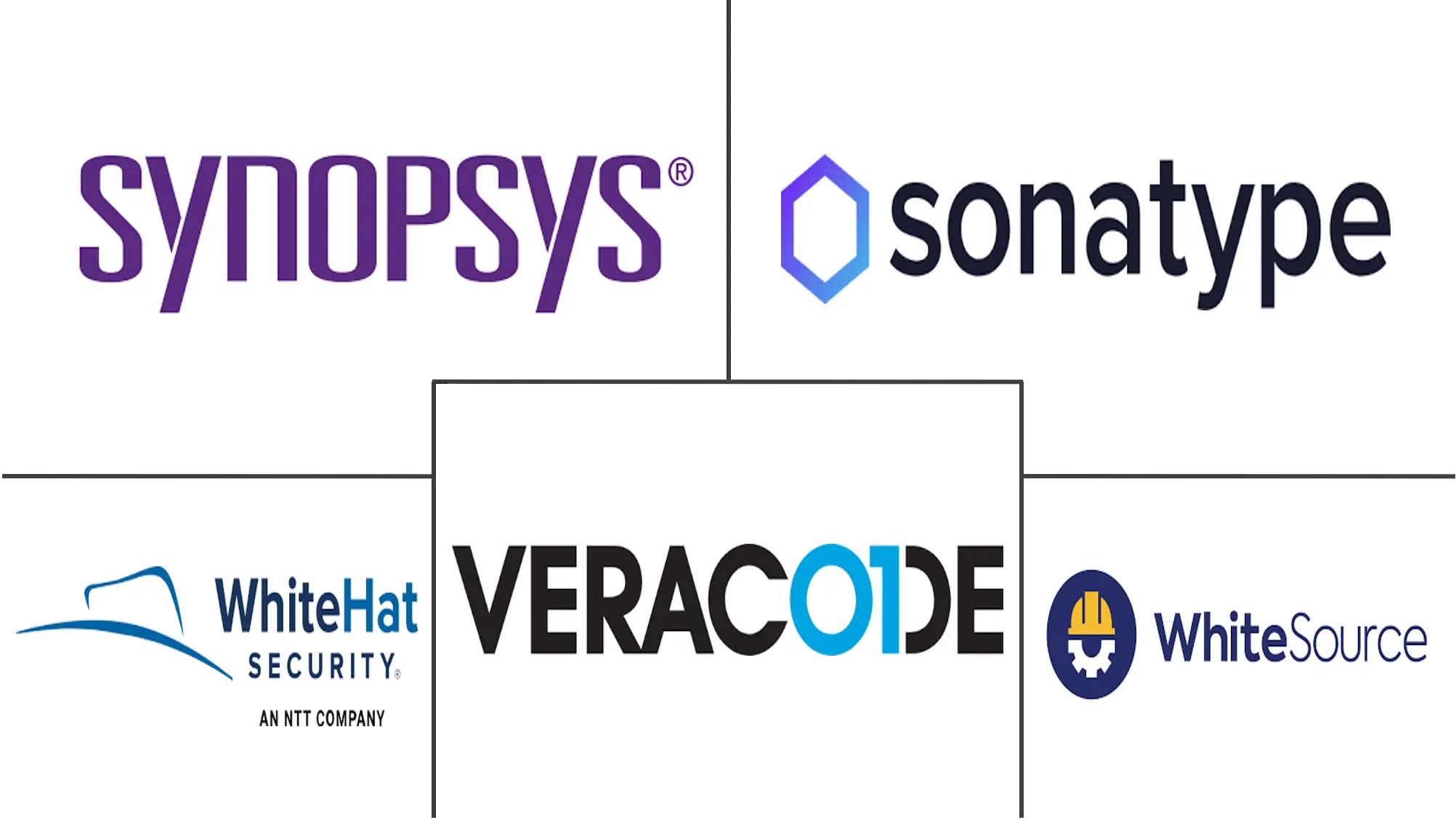Market Size of Software Composition Analysis Industry

| Study Period | 2019 - 2029 |
| Base Year For Estimation | 2023 |
| CAGR | 21.70 % |
| Fastest Growing Market | Asia-Pacific |
| Largest Market | North America |
| Market Concentration | Medium |
Major Players
*Disclaimer: Major Players sorted in no particular order |
Software Composition Analysis Market Analysis
The software composition analysis market is expected to register a CAGR of 21.7% over the forecasted period. due to the increasing reliance on open-source software (OSS) and the growing penetration of IoT and cloud-based services across numerous industries. SCA gives organizations automated visibility into OSS to provide security risk management, licensing compliance, security, and other management services against various risks, including open source vulnerabilities. This makes it a safer and more popular choice for organizations.
- With the increased use of open source codes, the number of open source vulnerabilities and threats is increasing, as is the acceptance of software composition analysis to successfully counter the risks. Open source software (OSS) has its advantages, such as simplicity of integration, a wide range of components, zero cost, and so on, as well as disadvantages, such as OSS license compliance risk, OSS security risk, OSS quality risk, and so on. These open-source vulnerabilities provide extraordinarily lucrative potential for hackers. According to Sonatype's sixth annual state of the software supply chain study, there has been a 430% increase in next-generation assaults that target open-source component vulnerabilities directly to infect software supply chains.
- According to the Reserve Bank of India, PhonePe had a 46% share of universal payments interface (UPI) usage in India in the last fiscal year, followed by Google Pay with a 34% share. Leading fintech companies have been important drivers of UPI adoption in India. The study market could grow as a result of the widespread use of mobile payments.
- SCA tools check package managers, manifest files, source code, binary files, container images, and other objects. The open source is assembled into a bill of materials (BOM), which is then compared against several databases, including the National Vulnerability Database. These databases contain information on known and prevalent security flaws. The National Vulnerability Database (NVD) is a vulnerability database maintained by the US government. Synopsys' internal vulnerability database, Black Duck KnowledgeBase, is the industry's most complete compilation of open-source project, licensing, and security information.
- In the last few years, businesses have used online transactions more because of the pandemic.COVID-19 and the resulting constraints compelled people to conduct more business online. The necessity of digital transformation influenced firms' time to market. Businesses reduce the time it takes to bring things to market, whether in chains, pieces, or versions. On the other hand, these firms must exercise extreme caution to avoid leaking data or allowing room for vulnerabilities or exploits. For security reasons, every version of a product that is launched must go through the SCA procedure. Such a transition toward digitalization would have created opportunities for the previously researched market during the pandemic.
- One of the most significant barriers to the adoption of software composition analysis is the scarcity of skilled workers. Due to a lack of training and skilled staff, each maintenance crew member devises their own methods for using the program. As a result, the database grows more complicated and disorganized. The organizations are unable to access the paid-for time-saving features. As a result, competent labor is one of the most significant issues in the software composition analysis industry.
Software Composition Analysis Industry Segmentation
Software composition analysis (SCA) is a software tool utilized to provide security from possible cyber threats. The software is accountable for conducting complete software code security analysis and monitoring open-source contents at every stage of the software development life cycle (SDLC). There are a wide range of SCA tools on the market that can be used to manage the quality, security, and license compliance risks that come from using open-source and third-party code in applications.
The Software Composition Analysis Market is split up by component (solutions, services), deployment mode (cloud, on-premises), industry vertical (IT & Telecom, BFSI, Retail & ECommerce), and geography (North America, Europe, Asia Pacific, Latin America, the Middle East, and Africa).
The market sizes and forecasts are provided in terms of value (USD million) for all the above segments.
| By Component | |
| Solution | |
| Services |
| By Deployment Mode | |
| Cloud | |
| On-premises |
| By Industry Vertical | |
| IT & Telecom | |
| BFSI | |
| Retail & E-Commerce | |
| Government | |
| Other Industry Verticals (Healthcare, Automotive) |
| Geography | |
| North America | |
| Europe | |
| Asia-Pacific | |
| Latin America | |
| Middle East and Africa |
Software Composition Analysis Market Size Summary
The software composition analysis (SCA) market is poised for significant growth, driven by the increasing reliance on open-source software (OSS) and the expanding adoption of IoT and cloud-based services across various sectors. SCA provides organizations with automated insights into OSS, enhancing security risk management, licensing compliance, and overall management services to mitigate risks associated with open-source vulnerabilities. As the use of open-source code rises, so does the prevalence of vulnerabilities, making SCA an essential tool for organizations to safeguard their software supply chains. The shift towards digital transformation, accelerated by the pandemic, has further underscored the importance of SCA in ensuring secure and efficient online transactions.
Cloud deployment is experiencing rapid growth within the SCA market, particularly among small and medium-sized enterprises (SMEs) due to its cost-effectiveness and operational benefits. The transition from on-premise to cloud-based solutions is expected to continue, driven by the need for organizations to focus on core competencies while leveraging cloud providers for IT infrastructure and management. North America is anticipated to lead the market, supported by early technology adoption, increasing digital banking usage, and stringent regulatory frameworks. The market is moderately competitive, with major players engaging in mergers, acquisitions, and product innovations to maintain their competitive edge and expand their global presence.
Software Composition Analysis Market Size - Table of Contents
-
1. MARKET INSIGHTS
-
1.1 Market Overview
-
1.2 Industry Attractiveness- Porter's Five Forces Analysis
-
1.2.1 Bargaining Power of Buyers/Consumers
-
1.2.2 Bargaining Power of Suppliers
-
1.2.3 Threat of New Entrants
-
1.2.4 Threat of Substitute Products
-
1.2.5 Intensity of Competitive Rivalry
-
-
-
2. MARKET SEGMENTATION
-
2.1 By Component
-
2.1.1 Solution
-
2.1.2 Services
-
-
2.2 By Deployment Mode
-
2.2.1 Cloud
-
2.2.2 On-premises
-
-
2.3 By Industry Vertical
-
2.3.1 IT & Telecom
-
2.3.2 BFSI
-
2.3.3 Retail & E-Commerce
-
2.3.4 Government
-
2.3.5 Other Industry Verticals (Healthcare, Automotive)
-
-
2.4 Geography
-
2.4.1 North America
-
2.4.2 Europe
-
2.4.3 Asia-Pacific
-
2.4.4 Latin America
-
2.4.5 Middle East and Africa
-
-
Software Composition Analysis Market Size FAQs
What is the current Software Composition Analysis Market size?
The Software Composition Analysis Market is projected to register a CAGR of 21.70% during the forecast period (2024-2029)
Who are the key players in Software Composition Analysis Market?
Synopsys, Inc. , Sonatype Inc. , WhiteHat Security, Inc., Veracode Inc. and WhiteSource Software Inc. are the major companies operating in the Software Composition Analysis Market.

